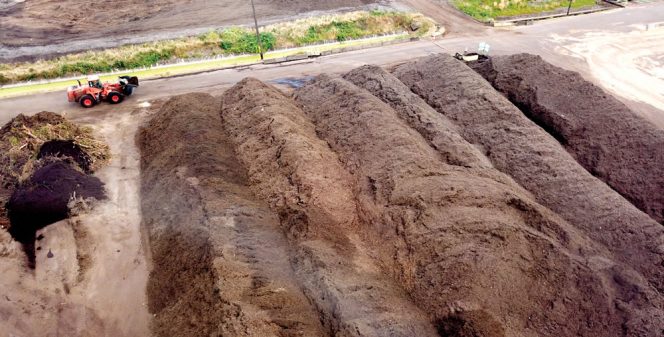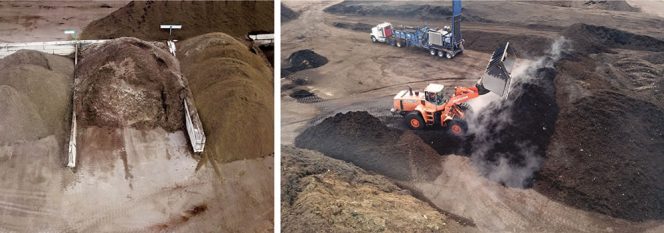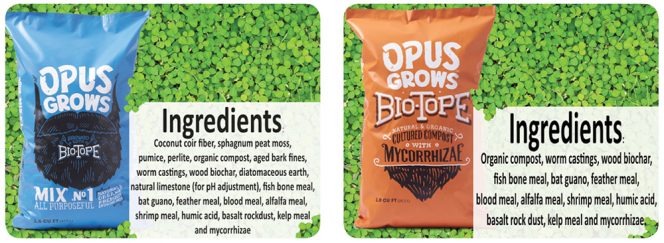The cannabis industry’s rapid growth has created a vexing challenge to producers — what to do with all the organic waste?
Peter Gorrie
BioCycle July 2018

Rexius in Eugene, Oregon receives cannabis waste that “is like any other green waste,” says Jack Hoeck, vice-president of environmental services.
These wastes are the stems and root balls, exhausted growing medium, failed plants, and diseased or otherwise unmarketable leaves, buds and seeds being produced in increasing quantities as more jurisdictions legalize marijuana for medicinal and/or recreational use.
Cannabis is now legal for medical uses in 29 states and the District of Columbia, and nine of those states have also approved it for recreational or “adult” purposes. In Canada, medical use has been legal since 2001 and recreational use is to be allowed across Canada as of October 17, 2018.
Its organic waste output, roughly estimated at several million pounds annually across the United States, is small when compared with food industry, agriculture and other sources. But a combination of the plant’s unique qualities and strict government controls make waste handling a complex matter. “It’s not a waste problem, it’s regulatory,” says Alfred Wong, president of Micron Waste Technologies, which has introduced an aerobic system to treat cannabis waste.
Disposal Regulations
State and provincial governments have enacted detailed regulations for all aspects of cannabis production and use. The requirements vary from state to state, and even among local jurisdictions within a state. They typically apply to larger, licensed growers — not to those allowed to grow a few plants for their personal use, or to ease medical conditions.
Despite the differences, the aim is generally to maintain quality control and ensure the drug isn’t diverted into the black market, an important consideration when cannabis remains illegal in a neighboring jurisdiction or when consumers consider legal market prices too high. The regulations governing producers’ organic wastes are as comprehensive as the rest. Unlike other agricultural industries, cannabis growers in most areas must keep exhaustive records of every ounce of material they discard. Some jurisdictions require that each plant get its own identification and tracking tag, or that senior managers from the producer accompany the wastes to any external disposal site.
Oregon’s rules are typical: Detailed data must be entered into the state’s Cannabis Tracking System. In addition, growers “must maintain accurate and comprehensive records regarding waste material that accounts for, reconciles, and evidences all waste activity related to the disposal of marijuana.”
Growers usually must keep cannabis waste inside a secure storage area with access limited to authorized personnel. These areas must be under constant video surveillance, with the images retained for up to 90 days.
Most states, and Canada, require that the materials be held unaltered for three business days. This delay allows time for an inspection if there’s concern about how a grow operation is being managed.
Thieves will break locks to get at the wastes, notes Bob Barrows, waste policy analyst with Oregon’s Department of Environmental Quality. The material deemed to be waste has little or no potency, because cannabis is so valuable that none of the marketable material is left on the plant, Barrows adds. “It’s not useful, but people do it anyway … thinking they’ll get something out of it.”
Careless handling of the wastes could get growers in trouble with federal authorities. They can’t, for example, just put it out with the trash because cannabis remains illegal under the U.S.-wide Controlled Substances Act and police don’t need a warrant to search garbage that’s outside a business.
Management Options
Growers generally have four options for their organic wastes:
• Those who cultivate cannabis outdoors can compost the residuals on site and apply the compost to their fields as a soil amendment. Some states limit the amount that can be applied in this way. Oregon, for example, allows up to 100 tons per year, “as long as there are no pollution or odor issues,” Barrows says. A composting facility permit would be necessary for more than 100 tons annually as long as county zoning allows it.
• In the Bokashi process, the wastes are shredded and dropped into an onsite drum that can be made airtight. Inside the drum (usually with about 55-gallon capacity), the wastes are mixed with at least an equal amount of other compostable material, water and an activator. After two weeks in this biologically active, anaerobic environment, the process produces a liquid, suitable for use as a fertilizer, and a solid portion that can be applied as a soil amendment. The short processing time, and its small footprint, make the Bokashi process appealing. But determining the correct amount of activator is crucial and challenging, according to a Best Management Practices Guide, published last fall by the Department of Environmental Health, in Denver.
• Micron Waste’s system is an example of a newer aerobic option. The company is commissioning its first commercial installation at a 55,000-square-foot facility in rural Cremona, Alberta. The operation is owned by Aurora Cannabis Inc., based in Edmonton Alberta and one of Canada’s largest growers, with nearly one million square feet of cannabis processing facilities in operation or under construction. (Aurora also has a 9.9-percent stake in Micron.)
Micron’s system, designed for on-site installation, finely shreds cannabis wastes and combines them with a proprietary blend of bacteria in an aerobic chamber. It includes further treatment that cleans the liquid residue to a standard that enables sewer disposal or nonpotable on-site uses. The extremely tough, fibrous stems from the large cannabis plants in industrial grow operations must be ground very fine for the bacteria to process them quickly, Wong explains. Micron says it has developed shredding equipment able to handle 1.5 tons/day, which would be adequate capacity for an 800,000-square-foot growing facility.
• Most common, and the minimum requirement set by most governments, the wastes can be shredded or compacted, then mixed onsite with at least an equal amount of other material, either organic or inorganic. The aim is to render it unrecognizable and unusable so that no one will attempt to imbibe or sell it, or use it to grow new plants outside the regulated system. After that step, the mixture can be handled like any other waste.

Soil and ingredient bins (left) used for preparation of custom mixes, including outdoor growers of cannabis. Loader (right) mixes various ingredients. Photos courtesy of Rexius
Composting Option
If the wastes have been combined with inorganic garbage, the mixture must be trucked to a landfill site. If incorporated with other organic waste, it can be trucked to a composting facility or anaerobic digester. Most jurisdictions allow growers to choose between the inorganic and organic disposal routes. To date, where facilities are available, the majority have chosen composting.
Compost feedstock that includes cannabis is “like any other green waste … it composts just fine,” notes Jack Hoeck, vice-president of environmental services at Rexius, which operates a composting facility in Eugene, Oregon. There’s no issue with potential diversion to the illegal market, Hoeck adds: “By the time we get it, they’ve taken everything marketable off the plant.”
But the composting option faces impediments: Composting facilities often aren’t available within a financially viable transport distance from producers; some grow operations have too little noncannabis organic material to create the required 50/50 mixture; and it involves the logistics and expense of separate collection of all organic wastes — cannabis and noncannabis — throughout the facility.
Canada’s approach to cannabis organic waste management has been typical. The federal agency, Health Canada, doesn’t ban landfilling but advises: “Composting may be an acceptable method of destruction of cannabis plant residue and other organic wastes” if it is “altered or denatured to such an extent that its consumption and propagation are rendered impossible or improbable.”
In a presentation to a Canadian Senate committee that held hearings in Spring 2018 on the Cannabis Act, the law that would legalize recreational use, the Compost Council of Canada stated: “We believe that composting should be the preferred method to process cannabis residuals. Landfills … emit greenhouse gases with organic residuals being responsible for 90 percent of these emissions.”
Last January, the Cannabis Conservancy — an advocacy group based in Nelson, British Columbia — stated in a brief submitted to a Canadian government consultation process that “the issuance of licenses under the Cannabis Act should be awarded to applicants who demonstrate the ability to meet baseline commitments to environmental sustainability,” including recycling organic wastes. “By requiring excess plant material and soil to be composted and giving preference to onsite composting, Canada (would prevent) plant material from ending up in landfills and reduces the costs for local governments to dispose of these materials.”
Peter Gorrie is a Contributing Editor to BioCycle.











